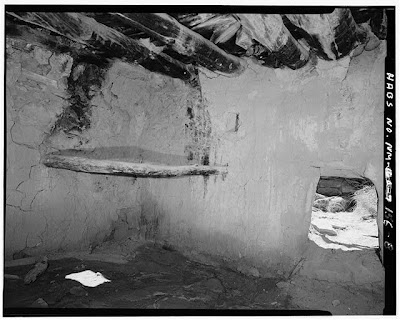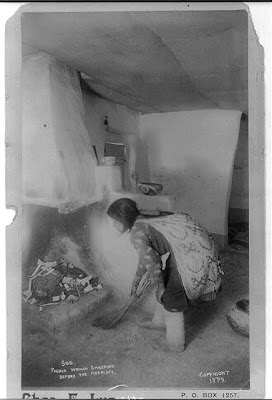
As a kind of counter to the Quintessential New Mexico Ranch I posted about the other day, and the number of posts I've made about New Mexico Ruins (which are everywhere)I thought I'd put up something a little less Show Business and a little more "Santa Fe Style."
The house above is at 502 Abeyta Street in Santa Fe, currently listed by Sotheby's for $1,200,000, which is far more than any ordinary New Mexican could ever hope to afford, but it's a fairly typical price for small -- but stylish -- quarters in Santa Fe's fashionable Eastside.
The principal selling point here is the Style.
The soft adobe forms, the huge rough-hewn columns and beams, the turquoise painted carved courtyard gate, the scrap of lawn, the flower containers, the rough brick pavement, the multipaned windows and a multiplicity of French doors. Yes, this house fairly screams, "Santa Fe!!!!"
Inside, the place is tamer than many Santa Fe Style houses. Almost serene:

Nevertheless, there are plenty of kiva fireplaces tucked in the corners of the rooms, merrily burning their pinon wood at all times of the year -- at least when the cameras are there. Pinon has a very distinctive smell which is quite charming in the wintertime, emblematic of New Mexico, much like the aroma of roasting chiles is the emblematic odor of New Mexico in the fall.
The story of corner fireplaces in New Mexico is kind of interesting. They are based on Indian Pueblo designs... sort of. Pueblo peoples built large adobe communal residences, essentially apartment houses, in which several dozens or hundreds lived, worked and stored their things. Many of these pueblos still stand, though they have been rebuilt and altered several times over the centuries, and in some cases their residents have adopted other kinds of housing which they tend to prefer over the traditional pueblo style.
Traditional pueblo rooms might or might not have a fireplace in the corner, but kivas -- ritual rooms generally underground -- never did because they didn't have corners. They were round. Residential rooms in pueblos were not kivas, and they were generally square or rectangular so there could be a fireplace in the corner. Or maybe there would be one in the center of the room. Or maybe there would be none at all.
Here are a couple of pictures of early pueblo corner fireplaces. The first is -- of course -- in a ruin (at Tapacito in Rio Arriba County); the second is of a fireplace in use in 1899, probably at Laguna or perhaps Isleta Pueblo.


Of course neither of them resemble the traditional "kiva" fireplace which is so essential to Santa Fe Style. The first one is simplicity itself -- a place for the fire in the corner of the room with a stone shelf above and a small hole in the ceiling for the smoke to get out (recognizable from the small bright square on the floor). The second is more elaborate and includes a hood over the fire and a chimney to get the smoke out more efficiently. But both respect the concept of a corner and both are straight-lined without the roundedness of the typical Santa Fe Style "kiva" fireplace.
The rounded corner fireplaces so typical of Santa Fe Style appear to be based on the "horno" -- outdoor ovens -- that are still widely used in New Mexico by Indians, Spanish and Anglos, especially to bake what's known as Oven Bread.


Yum!
By translating the horno, or part of it at any rate, to the interior of a pueblo revival room (cf: Wilfred Stedman) one achieves quaintness and style, and nothing is more important to Santa Fe than quaintness and style. And lots of money...
Let's return to the home under consideration at 502 Abeyta St.
At $1.2 million, it's mid-priced by Santa Fe standards, though in the right location it could go for a lot more.

It is just so... charming... after all.

Who could resist a meal al fresco on a porch (known as a portal) like this?
And of course there are shrines and images of Our Lady of Guadalupe everywhere. Even over the toilet.

(furnishings not included)
It's very important to have Our Lady on call in New Mexico, you see. I have no objection, though there are stories that perhaps the vision and portrait claimed by the Church and attributed to Juan Diego c. 1531 near Mexico City weren't quite what they were made out to be. Of all things.
Saints and shrines and nichos to put them in are as essential to the Style as kiva fireplaces and softly rounded adobe walls are.

Some would dare call it Santa Fe Kitsch.
Well.
No comments:
Post a Comment